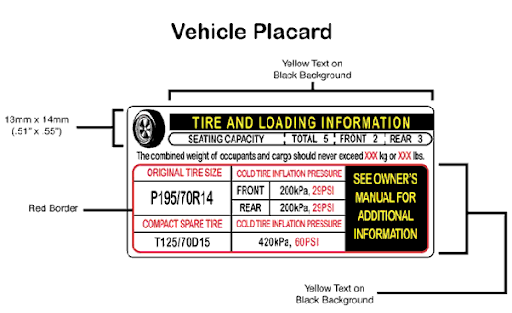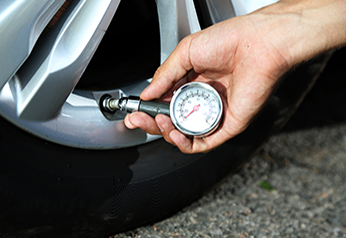
April 08, 2022
Your Tyre Load Rating Explained
Buying new tyres with the wrong load rating is dangerous. Too much weight might damage your tyres and cause an accident.
This guide hopes to explain what tyre load ratings are and why it is essential to buy a tyre with the correct rating.
What is your Tyre Load Rating measuring?
Tyre load rating - also known as tyre load index - is the heaviest load or weight your tyre can carry while moving at the maximum speed it is allowed, provided that it has the correct tyre pressure.
A number represents your tyre load index. The higher the number, the greater its load-carrying capacity. For example, A load index of 62 is equivalent to 265 kilograms and that final weight is the maximum load-bearing capacity of that tyre.
Tyre Load Index Safety Reminders:
-
The tyre load index on your tyre is just for that one particular tyre and not the total number for all four tyres.
-
Always drive on four tyres with the same load index.
Never drive with tyres that have different load ratings from each other. You could lose control of your vehicle and it will promote uneven tread wear and even cause a blowout.
How is Tyre Load Index determined?
Tyre load ratings are set by the tyre manufacturers themselves since they design and produce the tyre. They take the following into consideration when setting the load index:
1. Vehicle's weight
2. Tyre Weight
3. Weight of the maximum number of passengers
4. Weight of its cargo / what it can carry
5. The additional weight of the force gets added when the car is in motion.
When they have determined the rating, the tyre engineers will run tests to see if they gave the tyre the correct load rating or not.
TYRE ADVICE:
What Load Rating should I search for?
If your current tyres are your vehicle's original tyres, check the load index on its sidewall and the tyre placard. If they are replacement tyres, check your vehicle's manual and tyre placard.
Where can I find my Tyre's Load Index?
1. Tyre code
You can find the tyre load rating on the sidewall of your tyre as part of the tyre code. It is located after the tyre size information, specifically the diameter measurement and before the tyre's speed rating.

2. Tyre placard on the sidewall
The load index can also be found on your vehicle's tyre placard. The placard for your tyres could be in your glove box, driver's door, or inside the fuel cap. It identifies the number and location of seating positions and the total load capacity for occupants and luggage.

3. Owner's manual
Your vehicle's manual will also have the tyre load index information. You can also get in touch with the car company themselves or check online if you no longer have it but make sure that what you are getting is the correct manual.
Does tyre pressure affect Tyre Load Rating?
Your tyre's load rating is only accurate when the tyre is correctly inflated, with the prescribed amount of tyre pressure.
Regularly check your tyre's air pressure - as well as get proper tyre rotation, wheel alignments and balancing - to ensure a safe trip, with the right amount of weight in the car.
What happens if I use tyres with the wrong load rating?
Lower rating
It is EXTREMELY DANGEROUS to use a tyre with a load index lower than what your car's manufacturer prescribed.
1. Tyres will wear out faster, wasting money and requiring you to replace them earlier.
2. Too much load causes tyre blowouts which can be fatal not just for you but anyone else out on the road with you.
3. Your tyres - and vehicle - will lose driving stability and your ride will no longer be comfortable.
4. In case of an accident, your insurance company may refuse to cover your vehicle if it uses tyres not recommended by the car manufacturer.
5. Driving around using tyres with the wrong Load Rating is illegal and punishable by law.
Higher rating
It is possible to use a tyre with a higher load rating than recommended by your vehicle's manufacturer. But are there any advantages to it?
1. A tyre with a higher load rating will provide enhanced cornering capabilities and increased stability and control, especially at higher speeds.
2. However, since it is still not the correct load rating, it won't be as comfortable to ride in the vehicle.
3. There will be a higher rolling resistance, causing the car to consume more fuel as it fights the friction.
4. Tyres with higher load ratings are usually more expensive as well.
Tyre Load Rating Chart Australia
The different load index and speed ratings of a tyre can be found in the tyre load index chart or speed chart. This is the standard one used all over the world.
| Code | Weight | Code | Weight | Code | Weight | Code | Weight |
|---|---|---|---|---|---|---|---|
| 80 | 450 kg | 90 | 600 kg | 100 | 800 kg | 110 | 1060 kg |
| 81 | 462 kg | 91 | 615 kg | 101 | 825 kg | 111 | 1090 kg |
| 82 | 475 kg | 92 | 630 kg | 102 | 850 kg | 112 | 1120 kg |
| 83 | 487 kg | 93 | 650 kg | 103 | 875 kg | 113 | 1150 kg |
| 84 | 500 kg | 94 | 670 kg | 104 | 900 kg | 114 | 1180 kg |
| 85 | 515 kg | 95 | 690 kg | 105 | 925 kg | 115 | 1215 kg |
| 86 | 530 kg | 96 | 710 kg | 106 | 950 kg | ||
| 87 | 545 kg | 97 | 730 kg | 107 | 975 kg | ||
| 88 | 560 kg | 98 | 750 kg | 108 | 1000 kg | ||
| 89 | 580 kg | 99 | 775 kg | 109 | 1030 kg |
Need help?
Still have questions about your tyre load and speed rating, reach out via our contact page or social media accounts and members of #TeamTyroola will assist you.
Tyroola has a wide selection of tyres with all load index measurements available to match your car needs.
You can start shopping for the perfect set of tyres here.
If you’re not sure which tyres are right for you, Tyroola got your back. We have the perfect tyre for your needs. Buy now!



